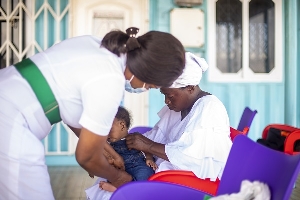The right to health is a fundamental human right enshrined in many constitutions and international instruments, including the International Covenant on Economic, Social, and Cultural Rights.
This year’s World Health Day theme, "My Health, My Right," underscores the right of all persons to quality health services and information regardless of who they are, where they live, or their financial status.
The right to health is in peril.
Rising conflicts, the skyrocketing cost of living, and the impact of climate change threaten to derail the enjoyment of these rights, particularly for the most vulnerable.
Furthermore, the Sustainable Development Goals (SDGs) report for 2023 shows that the world is off track to achieve SDG targets on HIV, malaria, and tuberculosis, and insufficient progress has been made to expand universal health coverage.
Achieving universal health coverage and other health-related SDGs would be impossible if we did not prioritize the right to health for the most vulnerable. As we mark this year’s World Health Day, specific and deliberate actions are urgently required to guarantee the right to health and ensure we leave no one behind.
Address social determinants of health:
All persons have the right to an adequate standard of living, including the provision of food, housing, and necessary social services. Providing these necessities contributes more to health outcomes than factors within the health system. Indeed, the World Health Organization (WHO) estimates that non-medical factors or social determinants of health account for between 30 and 55% of health outcomes. Thus, prioritizing the right to health would require that we go beyond the health sector and address the general conditions in which people live and grow.
The 2022 Ghana Demographic and Health Survey highlights maternal education and poverty as important predictors of malaria in children under 5 years. The provision of education, employment, adequate housing, and water, especially for the most vulnerable, including the urban poor, would help reduce health inequalities and improve health outcomes. The United Nations Development Programme's (UNDP) intervention to provide safe and hygienic sanitation solutions for urban slum areas in Kumasi is one key way to improve health outcomes for the urban poor in Ghana.
Make health services disability-friendly:
The Convention on the Rights of Persons with Disabilities (CRPD) recognizes that persons with disabilities have the right to enjoy the highest attainable standard of health without discrimination on the basis of disability. However, persons with disabilities face severe physical, informational, and attitudinal barriers that impede their ability to enjoy the right to health. Studies
reveal that in Ghana, entrances to most outpatient departments (OPDs) and the general hospital environment are not disability-friendly, and even in the few instances where there are ramps, these are often too rough, steep, or narrow for use.
To guarantee the right to health, we need to reexamine the architecture of health facilities and make them accessible. We also need to meaningfully
include persons with disabilities in the formulation and implementation of health policies, aligned with the phrase "nothing about us without us."
Health workers should also be equipped with the necessary skills and tools, including sign language, to provide disability-friendly health services. Through the implementation of the joint United Nations Partnership on the Rights of Persons with Disabilities (UNPRPD) project in Ghana, the United Nations (UN) in Ghana is strengthening disability data and supporting the reenactment of the disability law in line with the CRPD provisions.
Invest in women’s health:
Women and girls face major risks of unintended pregnancies, sexually transmitted infections, HIV, and depression, but often face many barriers to accessing health information and services. According to the latest World Economic Forum and McKinsey Health Institute report, the health challenges of women and girls are underestimated, underfunded, and underresearched. Women form the majority of the health workforce but hold a minority of global health leadership. Prioritizing the right to health for women and girls would mean investing in data systems to collect and analyze gender-disaggregated health data to accurately capture and address the health challenges of women, designing gender-responsive and transformative health policies, and providing adequate support and mentorship to ensure that more women attain leadership positions in health.
Conclusion:
With only a few years left to achieve the SDGs, it is imperative that we mobilize all available resources and partnerships to guarantee the right to health for the most vulnerable. Let us use the occasion of this World Health Day to reflect and take deliberate and concerted action towards universal health coverage. We cannot afford to leave anyone behind; we cannot afford to fail.
Opinions of Sunday, 7 April 2024
Columnist: Belynda Amankwa
Prioritizing the right to health to ensure we leave no one behind
Entertainment














